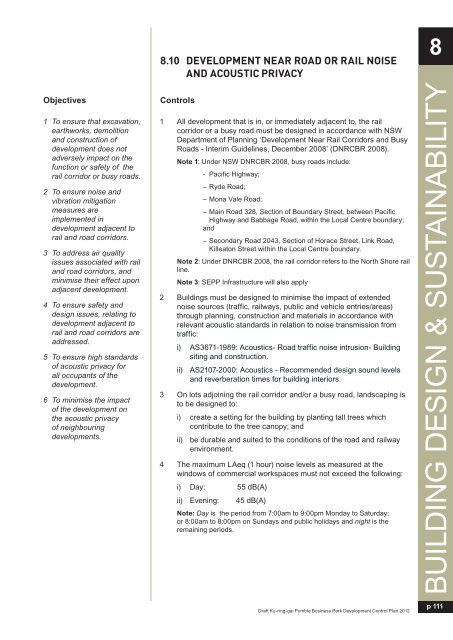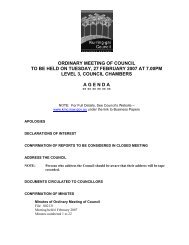Pymble Business Park - Ku-ring-gai Council
Pymble Business Park - Ku-ring-gai Council
Pymble Business Park - Ku-ring-gai Council
You also want an ePaper? Increase the reach of your titles
YUMPU automatically turns print PDFs into web optimized ePapers that Google loves.
8.10 DEVELOPMENT NEAR ROAD OR RAIL NOISE<br />
AND ACOUSTIC PRIVACY<br />
8<br />
Objectives<br />
1 To ensure that excavation,<br />
earthworks, demolition<br />
and construction of<br />
development does not<br />
adversely impact on the<br />
function or safety of the<br />
rail corridor or busy roads.<br />
2 To ensure noise and<br />
vibration mitigation<br />
measures are<br />
implemented in<br />
development adjacent to<br />
rail and road corridors.<br />
3 To address air quality<br />
issues associated with rail<br />
and road corridors, and<br />
minimise their effect upon<br />
adjacent development.<br />
4 To ensure safety and<br />
design issues, relating to<br />
development adjacent to<br />
rail and road corridors are<br />
addressed.<br />
5 To ensure high standards<br />
of acoustic privacy for<br />
all occupants of the<br />
development.<br />
6 To minimise the impact<br />
of the development on<br />
the acoustic privacy<br />
of neighbou<strong>ring</strong><br />
developments.<br />
Controls<br />
1 All development that is in, or immediately adjacent to, the rail<br />
corridor or a busy road must be designed in accordance with NSW<br />
Department of Planning ‘Development Near Rail Corridors and Busy<br />
Roads - Interim Guidelines, December 2008’ (DNRCBR 2008).<br />
Note 1: Under NSW DNRCBR 2008, busy roads include:<br />
- Pacifi c Highway;<br />
– Ryde Road;<br />
– Mona Vale Road;<br />
– Main Road 328, Section of Boundary Street, between Pacifi c<br />
Highway and Babbage Road, within the Local Centre boundary;<br />
and<br />
– Secondary Road 2043, Section of Horace Street, Link Road,<br />
Killeaton Street within the Local Centre boundary.<br />
Note 2: Under DNRCBR 2008, the rail corridor refers to the North Shore rail<br />
line.<br />
Note 3: SEPP Infrastructure will also apply<br />
2 Buildings must be designed to minimise the impact of extended<br />
noise sources (traffic, railways, public and vehicle entries/areas)<br />
through planning, construction and materials in accordance with<br />
relevant acoustic standards in relation to noise transmission from<br />
traffic:<br />
i) AS3671-1989: Acoustics- Road traffic noise intrusion- Building<br />
siting and construction.<br />
ii) AS2107-2000: Acoustics - Recommended design sound levels<br />
and reverberation times for building interiors.<br />
3 On lots adjoining the rail corridor and/or a busy road, landscaping is<br />
to be designed to:<br />
i) create a setting for the building by planting tall trees which<br />
contribute to the tree canopy; and<br />
ii) be durable and suited to the conditions of the road and railway<br />
environment.<br />
4 The maximum LAeq (1 hour) noise levels as measured at the<br />
windows of commercial workspaces must not exceed the following:<br />
i) Day: 55 dB(A)<br />
ii) Evening: 45 dB(A)<br />
Note: Day is the period from 7:00am to 9:00pm Monday to Saturday;<br />
or 8:00am to 8:00pm on Sundays and public holidays and night is the<br />
remaining periods.<br />
BUILDING DESIGN & SUSTAINABILITY<br />
Draft <strong>Ku</strong>-<strong>ring</strong>-<strong>gai</strong> <strong>Pymble</strong> <strong>Business</strong> <strong>Park</strong> Development Control Plan 2012<br />
p 111

















